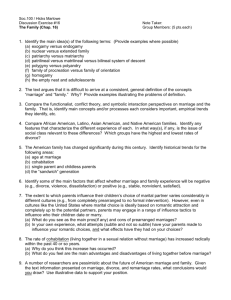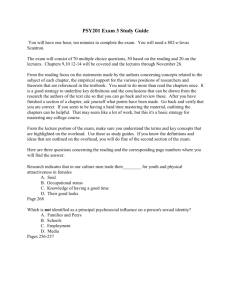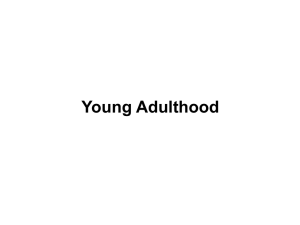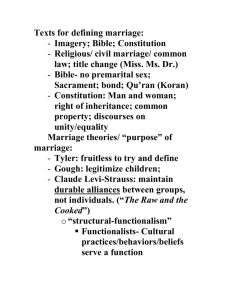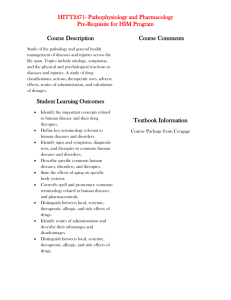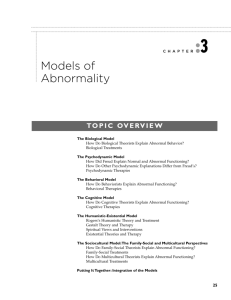Study Guide for the Final Exam
advertisement
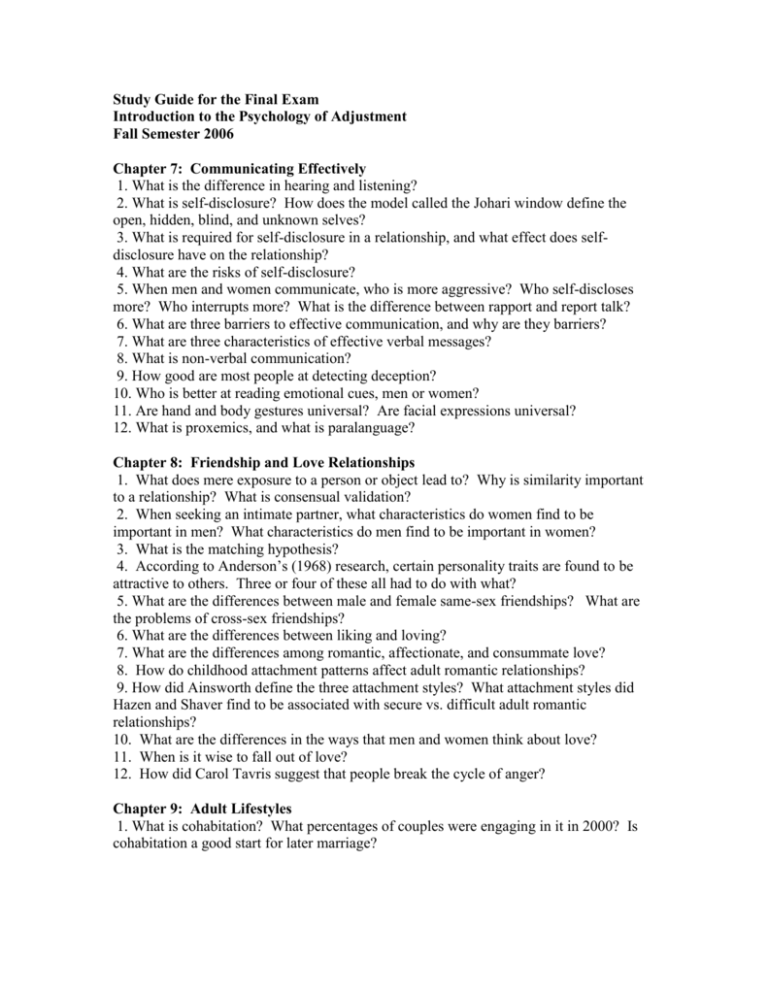
Study Guide for the Final Exam Introduction to the Psychology of Adjustment Fall Semester 2006 Chapter 7: Communicating Effectively 1. What is the difference in hearing and listening? 2. What is self-disclosure? How does the model called the Johari window define the open, hidden, blind, and unknown selves? 3. What is required for self-disclosure in a relationship, and what effect does selfdisclosure have on the relationship? 4. What are the risks of self-disclosure? 5. When men and women communicate, who is more aggressive? Who self-discloses more? Who interrupts more? What is the difference between rapport and report talk? 6. What are three barriers to effective communication, and why are they barriers? 7. What are three characteristics of effective verbal messages? 8. What is non-verbal communication? 9. How good are most people at detecting deception? 10. Who is better at reading emotional cues, men or women? 11. Are hand and body gestures universal? Are facial expressions universal? 12. What is proxemics, and what is paralanguage? Chapter 8: Friendship and Love Relationships 1. What does mere exposure to a person or object lead to? Why is similarity important to a relationship? What is consensual validation? 2. When seeking an intimate partner, what characteristics do women find to be important in men? What characteristics do men find to be important in women? 3. What is the matching hypothesis? 4. According to Anderson’s (1968) research, certain personality traits are found to be attractive to others. Three or four of these all had to do with what? 5. What are the differences between male and female same-sex friendships? What are the problems of cross-sex friendships? 6. What are the differences between liking and loving? 7. What are the differences among romantic, affectionate, and consummate love? 8. How do childhood attachment patterns affect adult romantic relationships? 9. How did Ainsworth define the three attachment styles? What attachment styles did Hazen and Shaver find to be associated with secure vs. difficult adult romantic relationships? 10. What are the differences in the ways that men and women think about love? 11. When is it wise to fall out of love? 12. How did Carol Tavris suggest that people break the cycle of anger? Chapter 9: Adult Lifestyles 1. What is cohabitation? What percentages of couples were engaging in it in 2000? Is cohabitation a good start for later marriage? 2. In 2002, what percentage of U.S. adults had been married at least once by age 55? What were the average first ages of marriage for men and women, and what percentage of marriages was ending in divorce? 3. In the U.S., what traits were rated most desirable in a potential marriage partner? 4. Do a person’s expectations about marriage matter? Are there any benefits to a happy marriage? During what years of a marriage does divorce most often occur? 5. What are four stresses of divorce that we discussed? What are the factors that enable divorced adults to cope effectively? You should be able to recognize descriptions of the six common pathways individuals take following a divorce. 6. Describe the four parenting styles that Diana Baumrind identified. Which one is most strongly-linked with the well-being of children? 7. What does research say about the detrimental effects of mothers working on the development of their children? 8. Does divorce seem to have an effect on children? Chapter 12: Gender 1. What is gender? 2. What do the social cognitive theory, cognitive developmental theory, and gender schema theory have to say about gender development in children? 3. What are instrumental and expressive traits, and how are they associated with power and gender? 4. Research conducted in 1982 found gender stereotypes in 30 countries. Describe the male and female stereotypes that they found. 5. You should be able to recognize the physical, cognitive and socioemotional differences between men and women. 6. What does the Bem sex-role inventory measure? Describe a person who scored in the androgynous category on this scale. 7. What are some special or additional stressors faced by women in the U.S.? (2 slides) 8. Explain the statement that men in the U.S. are facing role strain, and describe the effects of this. 9. What is the Mythopoetic Men’s Movement, and what does its existence indicate about the male gender role? Chapter 13: Sexuality 1. What is a sexual script, and what is the difference between traditional and romantic sexual scripts? What are the strengths and weaknesses of each? 2. What is a double standard, and what is the difference between male and female sexual scripts? 3. What is known and/or believed about the cause or etiology of sexual orientation? 4. What was the overall result of the 1994 Michael survey regarding Americans’ sex lives? 5. What is a paraphilia? You should be able to recognize descriptions of each of them. 6. What is transsexualism? 7. Name two STI’s that are potentially deadly and may be initially asymptomatic. Which other STI is among the most prevalent and whose complications may cause infertility in women? 8. How is rape defined? What is date or acquaintance rape? What percentage of college women report being raped in their lifetime? 9. You should be able to name and describe at least three adjustment strategies for the avoidance of date rape for women, and three for men. Chapter 14: Psychological Disorders 1. What are three criteria used to determine whether a person’s behavior is abnormal? 2. What are the differences between the biological and psychological approaches to mental illness? 3. What factors do the following approaches emphasize in the etiology of mental disorders: psychodynamic, behavioral, social-cognitive, sociocultural, biopsychosocial? 4. What is the DSM? When was it first published? What edition was published in 2002? What model does the DSM reflect? 5. What symptom is common to al of the anxiety disorders? 6. Describe a panic attack and panic disorder. What is agoraphobia? 7. What is the main characteristic of a phobia or phobic disorder? 8. What are the two main characteristics of OCD? Give an example of a compulsion. 9. What are the two types of mood disorders? What is a manic episode? How do psychodynamic theorists explain mood disorders? How do behavioral theorists explain them? What do cognitive explanations include? What is depressive realism? 10. What are the symptoms of schizophrenia? What is the diathesis-stress model or explanation of schizophrenia? Chapter 15: Therapies 1. What are the two major types of therapy for psychological disorders? 2. What is another name for anti-anxiety drugs, and in general, what effect do they have on those who take them? 3. What are benzodiazepines? What are some examples? Are they addictive? 4. What do antidepressant drugs do? How does prozac work, and what neurotransmitter do most of them target? 5. What is lithium used for? What do antipsychotic drugs do for those who take them? What neurotransmitter do neuroleptics target? Which one do atypical antipsychotics target? What is the only disorder that electroconvulsive therapy should be used for? 6. What is stressed in psychodynamic therapy? What is psychoanalysis? 7. What do humanistic therapies emphasize? Why are they called insight therapies? 8. What principles do behavior therapists use? What is systematic desensitization? 9. What is the goal of cognitive therapy? What is cognitive behavior therapy? What is integrative therapy? 10. What three elements do effective therapies share? Chapter 16: Health 1. Name three psychological factors proposed as causes of health problems. 2. What is the relationship of positive emotional states to immune and cardiovascular function? 3. What social factors influence health? 4. What is obesity? What is its prevalence in the U.S.? To what diseases is it linked? What is the vitamin controversy? What is the “low-carb diet” controversy? 5. What is the BMI or body mass index? What is leptin? What is BMR or basal metabolism rate? 6. What is the real problem with weight loss over time? What is yo-yo dieting? 7. Name at least three adjustment strategies for losing weight. 8. What is aerobic exercise? What can you do to your risk of heart attach if you exercise enough to burn at least 2000 calories per week? What is the minimum activity level recommended by experts? 9. How does exercise benefit mental health? What added benefit may accrue for aging or older adults? 10. How often do patients fail to follow their doctor’s advice? What does the doctor need to convince the patient about?
